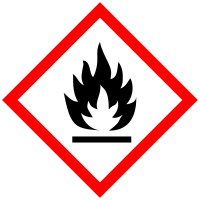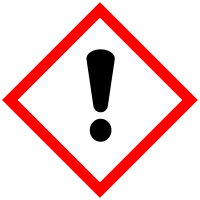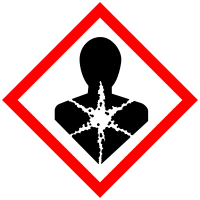
Improving Member States preparedness to face an HNS pollution of the Marine System (HNS-MS)
Ethylbenzene
Description Top
| CAS number | 100-41-4 |
| UN number | 1175 |
| Chemical formula | C8H10 |
| Standard European Behaviour Classification (SEBC) | Floater that evaporates (FE) |
GESAMP Hazard profile
| A1 | A2 | B1 | B2 | C1 | C2 | C3 | D1 | D2 | D3 | E1 | E2 | E3 |
| 2 | R | 3 | 1 | 0 | 0 | 0 | 2 | 2 | C | NI | FE | 3 |
Marine pollution Classification (MARPOL Annex II)
| Category | Description |
| Y | Noxious Liquid Substances which, if discharged into the sea from tank cleaning or deballasting operations, are deemed to present a hazard to either marine resources or human health or cause harm to amenities or other legitimate uses of the sea and therefore justify a limitation on the quality and quantity of the discharge into the marine environment. |
Alternate names for this chemical
Ethyl Benzene
Ethylbenzol
Eb
Phenylethane
Ethylbenzene
Ethylbenzol
Eb
Phenylethane
Ethylbenzene
Physico-chemical properties Top
| Chemical formula | C8H10 | ||
| Molar mass | 106.17 [g/mol] | ||
| Critical molar volume | 0.000374 [m³/mol] | ||
| State | Liquid at 25°C and 1 atm | ||
| Fusion temperature | -95 [°C] | ||
| Boiling temperature | 136.2 [°C] | ||
| Critical temperature | 617.5 [°C] | ||
| Density |
|
||
| Surface tension |
|
||
| Interfacial tension |
|
||
| Kinematic viscosity |
|
||
| Hydrosolubility |
|
||
| Vapour pressure |
|
||
| Critical pressure | 3609000 [Pa] | ||
| Vapour density | 3.3 | ||
| Flash point (Pensky-Martens closed cup) | 21 [°C] | ||
| Flash point (Cleveland open cup) | 26.7 [°C] | ||
| Lower explosivity limit (LEL) | 0.8 [%] | ||
| Upper explosivity limit (UEL) | 6.7 [%] | ||
| Vaporization enthalpy |
|
||
| Combustion enthalpy | 40900000 [J/Kg] | ||
| Specific heat capacity | 1725.5 [J/(Kg·K)] | ||
| Combustion efficiency | 70 [%] | ||
| Mass flow rate of the combustion surface | 0.07 [Kg/(m²·s)] | ||
| Radiative fraction | 60 [%] | ||
| Henry's constant | 798 [mol/(m³·Pa)] |
Behaviour Top
| Log Kow | 3.13 |
| Log Koc | 2.38 |
| Hydrolysis (Half-life) | Not hydrolysable |
| Aqueous photolysis (Half-life) | Not photolysable |
| Biodegradation in estuary environment (Half-life) | 15 days |
| Biodegradation in marine environment (Half-life) | 50 days |
| Standard European Behaviour Classification (SEBC) | Floater that evaporates (FE) |
| Bioconcentration factor (BCF) | 91 |
Ecotoxicity Top
| Lowest median lethal concentration (LC50) on algae | 3.6 [mg/l] | ||
| Lowest median lethal concentration (LC50) on crustacean | 1.8 [mg/l] | ||
| Lowest median lethal concentration (LC50) on fishes | 4.2 [mg/l] | ||
| Highest no observed effect concentration (NOEC) on algae | 1 [mg/l] | ||
| Highest no observed effect concentration (NOEC) on crustacean | 1 [mg/l] | ||
| Assessment factor (AF) |
|
||
| Predicted No Effect Concentration (PNEC) |
|
Hazards Top



Danger
| IDLH | 800 [ppm] |
Hazards statements
Physical
H225
Highly flammable liquid and vapour.
Health
H304
May be fatal if swallowed and enters airways.
H332
Harmful if inhaled.
H373
May cause damage to organs through prolonged or repeated exposure, exposure cause the hazard:
Environmental
H412
Harmful to aquatic life with long lasting effects.
Precautionary statements
Prevention
P210
Keep away from heat/sparks/open flames/hot surfaces. No smoking.
P240
Ground/bond container and receiving equipment.
P261
Avoid breathing dust/fume/gas/mist/vapours/spray.
P273
Avoid release to the environment.
P280
Wear protective gloves/protective clothing/eye protection/face protection.
Response
P331
Do NOT induce vomiting.
P301 + P310
IF SWALLOWED: Immediately call a POISON CENTER or doctor/physician.
P304 + P340
IF INHALED: Remove victim to fresh air and keep at rest in a position comfortable for breathing.
P305 + P351 + P338
IF IN EYES: Rinse cautiously with water for several minutes. Remove contact lenses, if present and easy to do. Continue rinsing.
Disposal
P501
Dispose of contents/container to ...
GESAMP Top
GESAMP Hazard profile
| A1 | A2 | B1 | B2 | C1 | C2 | C3 | D1 | D2 | D3 | E1 | E2 | E3 |
| 2 | R | 3 | 1 | 0 | 0 | 0 | 2 | 2 | C | NI | FE | 3 |
A1: Bioaccumulation
| Rating | Description |
| 2 | Low potential to bioaccumulate |
A1a:
| Rating | Description | Criteria [mg/l] |
| 3 | Moderate potential to bioaccumulate | 3 ≤ Log Kow < 4 |
A1b:
| Rating | Description | Criteria |
| 2 | Low potential to bioaccumulate | 10 ≤ BCF < 100 |
A2: Biodegradation
| Rating | Description |
| R | Readily biodegradable |
B1: Acute aquatic toxicity
| Rating | Description | Criteria [mg/l] |
| 3 | Moderately toxic | 1 < LC/EC/IC50 ≤ 10 |
B2: Chronic aquatic toxicity
| Rating | Description | Criteria [mg/l] |
| 1 | Low | 0.1 < NOEC ≤ 1 |
C1: Acute oral toxicity
| Rating | Description | Criteria [mg/Kg] |
| 0 | Negligible | AOTE > 2000 |
C2: Acute dermal toxicity (skin contact)
| Rating | Description | Criteria [mg/Kg] |
| 0 | Negligible | ADTE > 2000 |
C3: Acute inhalation toxicity
| Rating | Description | Criteria [mg/l] (4 hours exposure) |
| 0 | Negligible | AITE > 20 |
D1: Skin irritation or corrosion
| Rating | Description | Sign | GHS category |
| 2 | Irritating | Marked erythema, Obvio | Irritant Category 2 |
D2: Eye irritation
| Rating | Description | Sign | GHS category |
| 2 | Irritating | Marked conjunctival hy | Irritant Category 2A |
D3: Long-term health effects
| Notation | Hazard endpoint | Description | GHS category |
| C | Carcinogenicity | Chemicals which have been shown to induce or increase the incidence of cancer | Category 1 for Carcinogens |
E1: Tainting of seafood
| Rating | Description |
| NI | No Information |
E2: Behaviour of chemicals in the marine environment
| Rating | Description |
| FE | Floater that evaporates |
E3: Interference with the use of coastal amenities
| Rating | Interference | Description | Interpretation | Warning |
| 3 | Highly objectionable | 1 is highly acutely toxic; and/or 2 is severely irritant or corrosive to skin or eyes; and/or 3 is carcinogenic, mutagenic or reprotoxic; and/or 4 is a floater or persistent floater with associated health effects | 1 C1 and/or C2 and/or C3 = 4; and/or 2 D1 or D2 = 3, 3A, 3B, or 3C; and/or 3 D3 contains C, M or R; and/or 4 E2 = F or Fp and D3 contains Ss, Sr, T, A, N, or I | Warning issued leading to the closure of amenities |
GHS Security Information



Danger
About the project
HNS-MS is a decision-support tool that Belgian and French maritime authorities as well as coastguard stations can activate in order to forecast the drift, fate and behavior of acute marine pollution by Harmful Noxious Substances (HNS) accidentally released in the marine system.
Contact us
Copyright © 2015–2025 HNS-MS Consortium
 HNS-MS has been funded by DG-ECHO under agreement ECHO/SUB/2014/693705 and runs from 1 January 2015 to 31 March 2017.
HNS-MS has been funded by DG-ECHO under agreement ECHO/SUB/2014/693705 and runs from 1 January 2015 to 31 March 2017.